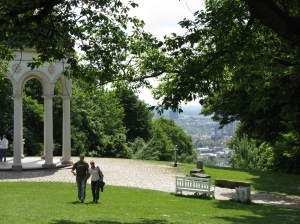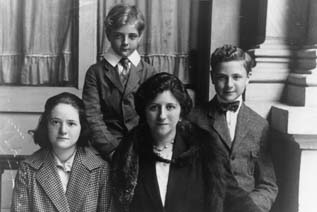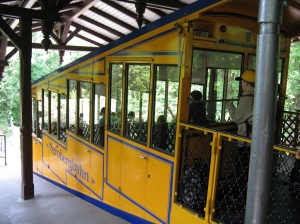FAMILY TREE
Thanks to the Internet, it’s relatively easy these days to trace your family tree.
But beware: a few clicks can shatter carefully crafted family legends and result in real time travel to totally unexpected places.
One listing on the Ellis Island site lead us to a lichen covered gravestone in a small Jewish cemetery in Wiesbaden, Germany, not at all where we expected to find my grandfather.
My family name is Tree and our Anglo-Saxon roots run deep in Surry, England.
Or so I believed for more than 50 years, until the day my husband’s web search exploded the family story that my grandfather, M. Maxwell T. Tree, was a pioneer pilot with the French Foreign Legion, shot down over Germany in 1918. An Ellis Island passenger recorded him sailing into New York Harbor in 1921.
My retired journalist husband Bill was like a bloodhound on the scent. The 1920 NYC census revealed my grandfather’s German ancestry and his passport application lead to the discovery that in 1917, the year the US entered World War I, he had changed his name from Tannenbaum (fir tree in German.)
That application introduced us to the great grandfather I had never heard of: Lippman Tannenbaum. He had arrived in New York in 1868. According to his passport application, he was born in 1851 in the village of Mansbach in the German state of Hesse.
This great grandfather left an extensive paper trail, much of it in the New York Times. From the 1890s until at least 1904 he was owner or co-owner of Himalaya Mining Co. near San Diego, said to the largest tourmaline mine in the world. As a prominent NYC jeweler, he had been commissioned by Tiffany & Co. to find and run such a mine specifically to satisfy a demand for tourmaline by the Chinese court which, however, seems to have represented its only market, one that collapsed with the revolution. The mine is still operated as a tourist attraction.
Judging from Ellis Islands passenger records, L. Tannenbaum sailed frequently back and forth between England and NYC. In Germany we also discovered him, while living in New York, sailing from Bermerhaven with his with his 58-year old mother. We can find no trace of her coming to the US, which suggests there were close relatives elsewhere in Europe.
All very interesting but initially genuinely horrifying. I’m an only child who adored and thought she knew her father, who had told me only of a grandfather Williams, a romantic figure who was a friend of Sam Clemens , an adventurer who made and lost fortunes and ultimately disappeared.
Then there was the story about my grandfather. We have inherited a quantity of silver and books that bear his name M. Maxwell T. Tree.
Now we know that first “M” is for “Marius”, which—we discovered in the state archives in Hesse—was the name of his grandfather, a cantor in Mansbach. Born Marrius Tannenbaum in 1877 in his father’s house on The Bowery, my grandfather –according to his passport statement –lived in Enlgand and Paris before meeting my grandmother who’s name was not—as I had been lead to believe—Margaret Williams. She was born Clara Margaret Hertzberg in 1886 in Memphis. My father was born in 1907 at 300 west 109th street in Manhattan and the couple lived in Providence, then in a townhouse at 317 W. 71st St., NYC, near Riverside Drive. According to family legend, it is one in a row designed by Stanford White.
My grandfather describes himself as a “merchant” and seems to have speculated in semi-precious stones, among other things. In 1919 According to the NY Times, Tree & Co. of 6 East 46th St. filed for bankruptcy. In July, 1920 M. Maxwell T. Tree, president of the Products Corporation of America (cable address: pinetree) sailed for France with plans to visit France, England, Belgium and Holland. This we know from that blessed passport application which I have come to treasure, if only for the photo of my grandmother as a glamorous flapper girl. (I knew her only as a stately dowager). There is no record in this application of the three children.

What I would give to know where my father , his parents and siblings were for the next two-and-a-half years. According to my father (13 at the time) he was in school at in Paris and then Winchester College, one of England’s oldest “public schools”. I do have a stamp book that my father kept during this period and he datelines some pages. In 1921 he was at the Hotel Cecil, London, the Ritters Park hotel in Bad Hamburg and in October at the Hotel Kaiserhof in Wiesbaden, Germany. In 1922 my grandfather applied in Frankfurt (the nearest major city to Wiesbaden) to extend the passport for his family (this one includes the children) another two years, saying that he planned to travel widely in Europe.

| Hotel Kaiserhof |
Maxwell Tree died January 4, 1923 at the Kaiserhof, a spa palace that was so elaborate and vast that it was bombed by the allies who probably mistook it for municipal offices. My guess is that my grandfather suffered from gout (which also afflicted my father in his 40s), the reason for his prolonged stay at this spa. While it was the fanciest resort in town, this was a post-war period of extreme inflation in Germany and a few dollars went a long way.
The city records no cause for the death of Maxwell Tree at age 44. My grandmother was 39. We learend about that headstone in the cramped, gloomy, Jewish corner of Wiesebaden’s vast and beautiful Platterstrasse cemetery thanks to a dedicated group at The Spiegelgasse Archives Museum. For 20 years these volunteers, most of whom are not Jewish, have been reconstructing and telling the story of Wiesbaden’s 7000 Jewish residents driven from their homes during the Nazi regime. Roughly half, we learned, emigrated and the other half died. The volunteers at the Spiegelgasse Archives had researched the names on surviving gravestones and were able to give us a map of the cemetery with the precise grave marked.
That’s all there should have been to that. But it wasn’t.
Obviously my family had never meant me to find this place. My grandmother and father were Episcopaleans. There are no Tannenbaums in this cemetery but I have to assume, given the proximity to their home village, that there were relatives in Wiesebaden and certainly in the area. They would undoubtedly have taken charge of arrangements for this sad little family of foreigners.
We couldn’t find the grave. After an hour’s frantic hunting we gave up and accepted a ride from a local couple who insisted that we see the city’s mountaintop park, accessed via the Nerobergbahn, a vintage 1888 funicular.
We spent the remainder of the day exploring the sights my grandparents would have known. Weisebaaden is essentially a 19th century spa town and the casino, public mineral spring baths, rail station and much more survive from that era.
We were in Germany to write about roots travel and on a tight schedule which took us to Bremerhaven to the dramatic new Auswandererhaus (German Emigration Center museum) and to the even newer Ballinstadt Museum, also devoted to the emigrant experience in Hamburg. Both these museums are fascinating and together offer insights into the experience of millions of emigrants from Eastern Europe as well as Germany and have research centers where visitors can trace lineage. Unfortunately I had neglected to bring even the correct spelling of my mother’s Polish ancestors and we could learn nothing more about our Tannebaums. They fit no major emigrant profile.
Our frustration at the failure to find even my grandfather’s gravestone grew as the trip progressed and finally I determined to return to Wiesbaden on our last day. We had appointments in Frankfurt but were due to arrive in early afternoon and Bill agreed to cover for me. Commuter trains run frequently to Wiesbaden and I could taxi out to the cemetery and give it a last try. We phoned the volunteer at the Spiegelgasse Archives office who had located the grave for us. We were just asking for clues about why our initial attempt had failed but he offered to meet me at the cemetery.
That’s all there should have been to that but it wasn’t. At 2:30pm, the time our train was to arrive in Frankfurt, it arrived instead at Cologne, a good two hours away. We had no cell phone and could locate none on the train but, thanks to Bill’s sense of geography, I grabbed my suitcase and detrained in Minz, caught a local to Wiesbaden and was finally able to phone Georg Schneider, the long suffering volunteer who had been sitting by his phone, waiting for me to call for two hours. He met me at the graveyard and escorted me to the grave—not in the spot we had looked but not that far. Why we couldn’t find it initially I can’t explain.
Neither can I explain why actually finding this gravestone meant so much. My grandmother must have been responsible for the engraving on his simple headstone: “Beloved Husband, Devoted Father.” It seems fairly certain that she and the children were at the funeral. My father, Alfred E. Tree, was 15.
The family sailed back into New York from Antwerp in Spetember of 1923 and their address is that of a Williams relative in East Orange,N.J. What happened during the next few years is a mystery.
According to his 1941 application for a position with the U.S. Treasury, my father was at Bonn University from 1924 to 1926 and in NYC from 1926-1928, taking courses at the American Institute of Banking. Family legend has it that the family lived in Europe and that a rich old maharaja proposed to “Nonni” (my grandmother) but that my father persauded her to reject him. I’ve inherited a set of desktop elephants, said to be a gift from this suitor, who is said to have died soon after, leaving his fortune to another woman. In August, 1928, Ellis Island records Nonni sailing home from Cherbourg, giving a Riverside Drive address. My father later told me repeatedly that he would have much rather been a writer but his family depended on him to support them.
My father’s career began in 1929 as an intern in the foreign department (he spoke French and German) of the National Bank of Commerce in New York and he soon joinned Seligman & Co. as their European representative, based in Berlin. His pocket calanders, which I have, beginning in 1933, record an enviable life of golf, skiing, social appointments and stays at many of the continent’s best hotels. In 1936 D.M. Mnton & Co.,N.Y. stockbrokers, hired him to represent them in Europe and in 1938 he was in London, representing Goodbody Co. Altlantic crossings, professional and social appointments fill his calendars throughout these years. He notes meeting Hitler in Berlin and the day war was declared in London but otherwise says maddeningly little about what’s happening around him. Luckily his secretary in London in 1938-39 was a perceptive young Canadian ,Evelyn Belt ,who kept a journal, filled with vivd descriptions both of London under siege and of her boss. On 9/11/39 she notes: “AET has his dream at last…a big sign for his car ‘Police: Food Supply’ and a badge which lets him in any place in Scotland Yard. He now parks his car where he likes.”
It’s Evelyn’s journal (a copy from her daughter Jennifer arrived out of the blue, just as I was writing this) that reveals that my father tried to join an ambulance unit when the office was forced to close. At the time she also asks him if his father was killed “in the last war”. He says yes and “she felt blue all day to think he must never have known his father.”
It seems that already my father was telling the story recorded in his interview in 1941 with the U.S. Treasury Dept.:
“Father was killed in action in Jaunaury 1918.”I can understand that he might want to stress his father’s patriotism, given that the Federal Reserve might not want to hire someone of German descent who had spent so much time in Germany, but why mislead his young secretery ? When was this a story concocted and why?
My father flew to Honolulu in 1941was hired by the US Treasury as “head commercial specialist” in Foreign Funds Control for Hawaii and the Pacific. There he met Martha Rudneski, a Polish beauty from Morris Run, Pa. My mother had been working as a nurse at the Mayo Clinic in Rochester, Minnesota and was in the habit of spending her winters in Hawaii, working her passage on the Matson Liners. She was stuck in Honolulu when war was declared and so went to work at Queens Hospital.
My future parents had a date to meet for a picnic on Sunday, Dec. 7th, 1941. The previous evening my mother had attended at a party aboard the “Arizona”, the battleship sunk early the next morning in Pearl Harbor. According to my mother, some of her fellow nurses were still aboard. According to my father, he received a call from the officer in charge at Pearl Harbor that morning, asking him to look out his window at the Moana (in Waikiki) and identify the nationality of the planes dropping the bombs. Of course everyone knew who it was but there was too much smoke to actually see the planes at the base and so my father supplied a visual confirmation that the aircraft were painted with the rising sun emblem of Japan.
My mother liked to say that she only married my father because her head nurse urged her staff to find themselves a man to defend them when the Japaneses invaded. My parents were married in Honolulu’s Catholic cathedral the following April and moved into a (long since vanished bungalow on the grounds of the Halekelani Hotel. I like to think that I’m the only travel writer conceived at a hotel on Waikiki Beach. I was born in September, 1944 and my family was one of the first to fly out of The Islands in a Pan American “Tin Goose” a few months later.
My father has told me that he didn’t want to continue in the Foreign Service because he didn’t want his daughet to be, as he had been, “always the outsider”. He died in 1978 and how I wish I had pressed him about what his school experience had been. None of the schools he lists have a record of his having attended.
My father’s career continued to soar. He went to work for the Chemical Bank in New York and founded their foreign department, hiring Eveln Belt as his scretary. He traveled much of the year, roughly three months in Europe and at least two in the Middle East. He worked with many of the same colleagues with whom he had worked in his ’20s and stayed at many of the same hotels. He liked to tell the story of returning to the Connaught Hotel in London and being greeted by the doorman with “Welcome back Mr. Tree. We’ve saved you the umbrella you left before the war.”
Among my father’s many achievements are his work with the United Nations, opening a branch of the Chemical Bank at the U.N. in its formative years. He was also treasurer of the Near East College Association and a member of the Metropolitan and Pilgrim clubs, none of which would have been possible for a Jew. He became a Catholic. While my grandmother remained Episcopalian, she urged my parents to enroll me in the Convent of the Sacred Heart, a school catering to girls of good family in Europe. My father older sister Rita, she explained, had attended a Sacred Heart schoolin Belgium. I don’t remember ever meeting Rita, who died in upstate New York when I was young.
We will never know the truth about my family Tree. Now that Bill has found my father’s birth certificate, we know that he was born Alfred Edwin Tannenbaum. Why did he have to tell me he was born in the family townhouse on Washington Square instead of in an apaprtment on west 109th? I can only surmise that he told my mother all these things in 1941 and could never figure out how to backpeddle. My mother was a very literal person.
One family charateristic that seems a constant with the Tannebaum/Trees is the penchant to travel. I have married a fellow travel writer and we have three sons. Liam, the oldest is an artist with an MA in printing from the University of Hawaii. Tim, is married to Yuko Kodama who was born in Chicago but grew up in Tokyo, where the couple now regularly visit her family. I don’t think my mother anticipated having grandchildren named Aki and Taiga. Our third son has traveled widely and is presently teaching Medieval French literature at UC Berkeley. They are all delighted to discover their Jewish heritage.



